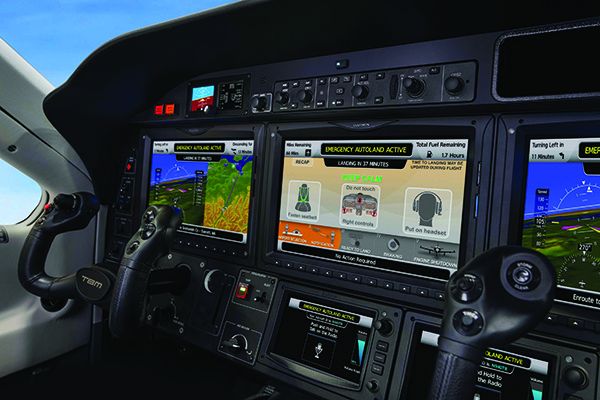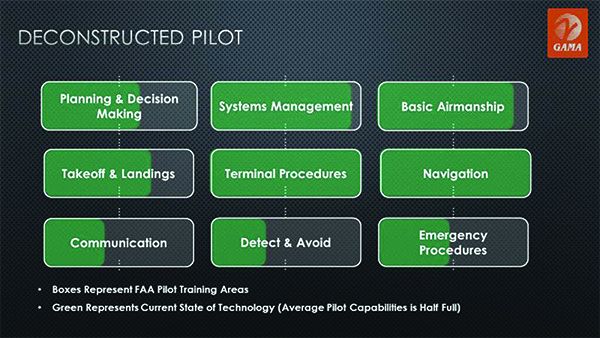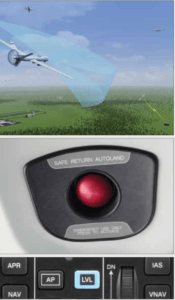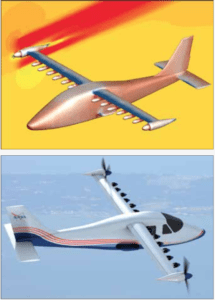
Aviation has always been a breeding ground for technological, social and economic change. Many of these changes, such as the jet airliner, shrank the world and transformed how we see it. The airliner’s influence may be on the wane, however, as challenges in the workplace and the effects of climate change—two major factors among many others—force a reduction in commercial air travel by making it less relevant and costlier without making it less unpleasant. At the same time, trending technologies may make air transportation more reliable and safer, and they’ll most likely first appear on aircraft similar in size and capabilities to the ones you and I fly.
A new concept, Simplified Vehicle Operation (SVO), is quietly being developed by manufacturers, trade associations, regulators and other stakeholders. Considerable resources are being invested to address safety and marketing objectives, as well as applications for new conventional aircraft designs and even retrofitting in-service aircraft. If this concept even partially succeeds, it could upend everything in the industry from pilot training to safety trends. The technology is mostly here, and it is not rocket science.
ONE VISION
The NASA vision, known as advanced air mobility and embraced by a long list of existing and emerging companies, and investors, describes a national system of short- and medium-range on-demand air transportation. We’ve seen some this before, of course, in NASA’s small aircraft transportation system (SATS), from the 1990s, elements of which are in use today. But the technology now is available to accomplish more of these goals. While operational and regulatory hurdles exist, the hardware and software needed to make NASA’s vision a reality are being developed today.
The vehicles generally are electric-powered vertical takeoff and landing (eVTOL) aircraft. The initial versions will have a human pilot, but all the engaged manufacturers are designing these aircraft to make a rapid transition to full automation, which will come in stages. For our purposes, one goal is to progressively incorporate systems adhering to the “simplified vehicle operations” concept, or SVO. The sidebar on the opposite page helps describe SVO.
The existing manufacturing community envisions a world in which SVO concepts will drive conventional new aircraft designs and be widespread in the retrofit market while eVTOL aircraft also are developed. This is no longer a pie-in-the-sky quest for new ways to automate cockpits: Garmin’s Autoland innovation, already certified in three aircraft models, is paving the way and the leap from emergency auto-land capability to full autonomous operation isn’t that great. Manufacturers recognize that SVO has the potential to drastically improve general aviation’s safety record, effectively eliminating a significant barrier to the industry segment’s utilization in the minds of passengers.

As stated in a recent NASA paper, simplified vehicle operations is a group of concepts that, at its most basic, “facilitate humans and machines working and thinking better together.” It is designed to “reduce the quantity of trained knowledge, skills, abilities, and experience that the pilot or operator of an aircraft must acquire to operate the system at the required level of operational safety.”
According to that paper (“Enabling Urban Air Mobility: Human-Autonomy Teaming Research Challenges and Recommendations,” delivered in June 2020), a key idea behind SVO is “the need to reduce the training footprint because of costs and projected shortage of qualified pilots.”
The graphic above, developed by the General Aviation Manufacturers Association (GAMA) in 2016, breaks down required pilot skills into nine categories, represented by the displayed boxes. The extent of green shading in each box reflects the then-current ability of technology to replace the pilot. Importantly, GAMA now recommends this matrix should be expanded, to 13 categories.
EFFECTIVE RISK MANAGEMENT?
As long-time readers know, I have been covering risk management issues in this journal for the last 10 years. Accident data evaluations demonstrate that poor risk management is a root cause of most fatal general aviation accidents. Recent changes in pilot training and certification—the FAA’s airman certification standards, or ACS—emphasize risk management techniques, but they still are not part of the general aviation safety culture.
One of the obstacles to progress is the way that accidents are investigated and classified by the NTSB and how they are interpreted by various industry aviation safety groups. The taxonomy emphasizes the final event in the accident chain, rather than real root causes. As an example, loss of control in flight (LOC-I) leads accident causes but if we look deeper, we find that poor risk management is a root cause for many of these accidents. Put simply, the accident pilot failed to identify, assess and/or mitigate known hazards and associated risks.
Conventional accident analysis—that which doesn’t consider risk factors—is not without value. It does a good job of illustrating the accident sequence but it must be coupled with root-cause analysis that, when done correctly, inevitably demonstrates the importance of risk management.
In the engineering world, certification, crew training and procedures are a last layer of defense to ensure safety. The first order of defense is designing safe operation into the system, beginning with the initial design and certification of the aircraft and avionics.
For the entire history of aviation, we have emphasized traditional airmanship and training as the primary route to avoiding accidents. We made great strides until about 20 years ago, but general aviation’s fatal accident rate basically has stagnated since (see the graph on page 27). I maintain that it is really technology that has moved the bar in the past and that airmanship and training have not been the crucial difference. The problem with pilots is that we are human. We do certain things well, yet our basic makeup often impedes effective behavior.

Numerous technologies will enable SVO. Some of these are already proven, some are nearly ready for prime time and some need to be developed further to support full automation. The following six deserve special mention.
Artificial intelligence (AI)
This is a bedrock capability that will drive functionality toward full automation. It is already widespread in many aviation and other applications and in a basic form it is, for example, integral to the current Garmin Autoland capability.
Detect and avoid
This capability is also critical. Autonomous aircraft will have to detect and avoid other aircraft and various hazards. Elements will include ADS-B as well as other sensors. We can expect the “rules of the road” to change and that will affect the rest of us.
fly-by-wire (FBW)
Direct manipulation of control surfaces and powerplants by pilots will be transferred to FBW, a now well-proven technology that will migrate to much smaller aircraft.
Intuitive flight controls
For on-board pilots or ground operators, there will be no need to worry about which control does what. You will only command speed and flight path desired or, ultimately, just your destination. The AI, FBW and envelope protection does the rest.
Envelope protection
The envelope protection provided by the Garmin “blue button” is merely the first wave of this technology. Fully implemented, this technology should eliminate most final LOC-I scenarios and CFIT crashes, the two leading GA accident “causes.”
Enhanced situational awareness (SA)
Effective risk management will no longer depend on dicey pilot compliance. Pilot tasks such as avoiding convective weather, fuel exhaustion, turbulence and other hazards will be performed automatically.
All of this may sound too futuristic, but these technologies are rapidly maturing or are already here. Since they fundamentally change the risk management equation, they could become the means to reduce general aviation accident rates significantly, as least for the fleet that is so equipped.
TECHNOLOGY TO THE RESCUE?
Garmin’s existing “blue button”—officially referred to as the return-to-level (LVL) autopilot mode—and its new Autoland technology are only the first wave of product evolutions that may ultimately prevent that final smacking the ground in a LOC-I or CFIT event. Expansion of these and similar technologies will enable early hazard identification, assessment and mitigation, preventing the aircraft from reaching that final stage where a LOC-I or CFIT event occurs. This evolution in aircraft control will inevitably affect both air carrier and general aviation aircraft. Scary? It will be to some in the current general aviation community, who might fear giving up their responsibility and control to an avionics system.
Meanwhile, you’re probably wondering if you’ll ever see any of this tech in your 1959 Comanche. You might be surprised. Capabilities such as partial envelope protection may be retrofittable to in-service airplanes. Newer designs will fare even better since the manufacturers (airframe and avionics) are already working together on integrating these capabilities at the factory.
The current avionics retrofit market can be characterized by expanding capabilities and plummeting costs. While totally autonomous operation is probably too difficult and expensive for the typical 50-year-old general aviation airplane, we can expect manufacturers to continually update their designs and migrate toward full automation.
IMPLICATIONS
Although long-term implications tend toward fully automated aircraft, it’s also likely that pilot training requirements will be slimmed down as greater automation is introduced. The FAA’s drone pilot rules already offer a subset of, say, a commercial pilot certificate. Another subset is the “centerline thrust-only” limitation for some multi-engine pilots. None of the tasks on current practical tests (i.e., check rides) would matter. The pilot certification required will be limited to certain SVO technology levels.
We might want to be more concerned about the operating environment we will ultimately share with these aircraft and resulting rule changes that will be needed. For example, autonomous aircraft may have priority in landing at conventional airports, even though VTOL operations may have its own infrastructure. Will they broadcast their position over CTAF frequencies when approaching conventional airports? Will there be discrete charted routes?
Also, will SVO improve safety? I expect this to play out in two principal ways. With any luck, the new class of aircraft will be well-designed and SVO technologies will have matured enough before commercial passenger service starts, which will require demonstrating high reliably levels. For our legacy aircraft, some of the technologies will trickle down, but risk management will still have to be accomplished the old-fashioned way, one flight at a time. It’s my hope we will rise to this challenge and make risk management a big arrow in our quiver.

One major effort to advance the state of eVTOL development is sponsored by the General Aviation Manufacturers Association (GAMA). The association created the Electric Propulsion Innovation Committee (EPIC) nearly two years ago to spearhead this effort.
EPIC has since spun off several subcommittees to address issues such as propulsion, batteries, control systems, and ground and air infrastructure. One of the most important of these is the SVO subcommittee, which is addressing all the technology, regulatory and other implementation areas. This includes flight crew licensing and certification. All the subcommittees include manufacturers, regulators (from both the FAA and the European Aviation Safety Agency) and other stakeholders. The SVO effort is well along and this team has produced several documents laying out the pathway to full automation.
Meanwhile, NASA is developing the X-57 Maxwell flight test aircraft, pictured at right. Based around a modified Tecnam P2006T airframe, the X-57 ultimately will be an all-electric fixed-wing aircraft testing the concept of distributing individually controlled electric motors—12, in this case—along a wing’s leading edge to blow air over the wings and enhance low-speed handling. The smaller motors would be disabled in cruise and the X-57 would rely on the two larger motors at the wing tips for propulsion. The top image is of a simulated wind tunnel test while the bottom one is an artist’s conception of the final configuration.
A SABBATICAL
Now that I’ve gotten all that off my chest, I’m taking a break from writing for Aviation Safety and other professional activities as well. I hope my observations on risk management have been helpful to all my readers. My “sabbatical” may only last a few months but it may be longer as I contemplate a different kind of retirement at age 72 and address some personal issues. I might turn back to writing historical novels, and finish a third one to follow my prize-winning Valhalla Revealed. We’ll see if I still have the creative juices.
In the meantime, please manage your risks carefully in whatever type of flying you are engaged in. Over 10,000 hours and 55 years, it has been the key to my safe operation. It can be for yours, too.
Robert Wright is a former FAA executive and President of Wright Aviation Solutions LLC. He is also a 10,000+hour ATP with four jet type ratings and he holds a Flight Instructor Certificate. His opinions in this article do not necessarily represent those of clients or other organizations that he represents.




I think we (aviation) are rapidly approaching the point where no significant reductions in the accident rate can occur with a protoplasm pilot at the controls. IMHO, we’re not quite to that moment… but soon will be. Of course, any time we reach for a techno solution we have to reach even further for the ability to PAY for it. We can see that fact clearly demonstrated in the 70 year old designs for new airframes and the new glass panels … soon to be equipped with auto land, and already equipped with terrain awareness, ADSB, ETC. TAANSTAFL (there ain’t no such thing as a free lunch) is why economists are infamous for practicing the ‘dismal science’. EVERYTHING associated wit new or retrofit aircraft is likely to be eye watering expensive. Whether the avionics packages, airframes, or engines. We’re already seeing some manufacturers make the airframes life limited for their already pricey aircraft —- a step that inflates the real cost of already expensive investments. What’s the residual value of a 6000 hour airframe with 5000 hours on it? Maintenance includes software and av-data updates at several hundred + dollars a pop. How about BRS mandatory chute inspections and repacking? Or replacing the fabulously expensive and environmentally destructive batteries of soon to be mandated e-aircraft?
We (people who engage in aviation) really have no significant control over the inevitable automation of the left seat (and right seat) of future aircraft. Or cookie cutter modularization of maintenance. I’m sure, had Kobe Bryant’s pilot been a soon-to-be-reality AI in-a-black-box a safe arrival of that aircraft would never been seriously in doubt. To play the coming game of aviation, all it will take is a seven figure income.